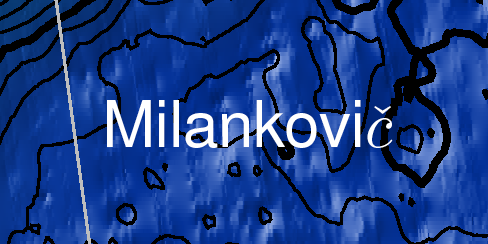I need to annotate some maps that have the letter “c” with a caron (upside-down hat). This letter is commonly used in Czech, Slovak, Serbo-Croation, etc. languages.
I do not see an octal code for this character. How can it be printed within GMT?
I need to annotate some maps that have the letter “c” with a caron (upside-down hat). This letter is commonly used in Czech, Slovak, Serbo-Croation, etc. languages.
I do not see an octal code for this character. How can it be printed within GMT?
Do you have Latex installed ?
I have TeXShop installed. Will that do?
Check it:
gmt begin GMT_latex
gmt set GMT_THEME cookbook
gmt basemap -R-200/200/0/2 -JX15c -Bxaf+l"@[\nabla^4 \psi - \Delta \sigma_{xx}^2@[ (MPa)" -BS
gmt end show
I get a nice scale bar with some text below. So I guess I have it! Never used LaTeX before!
Now you can try "@[\v{c}@["
I tried taking your expression and including the c-caron:
gmt begin GMT_latex
gmt set GMT_THEME cookbook
gmt basemap -R-200/200/0/2 -JX15c -Bxaf+l"@[ \v{c} \nabla^4 \psi - \Delta \sigma_{xx}^2@[ (MPa)" -BS
gmt end show
But nothing appears like a “č”, in the output PDF.
I just read chapter 13 in the GMT technical reference and saw the recommended TeX iinstallation. I’ve installed the texlive apps through MacPorts. That didn’t help. The @[\v{c}@[ still isn’t showing up in the output PDF.
Yes, looks just like that, on the first try. But still looks like that when I used the \v{c} in my second try. No error messages.
try \capitalcaron{c} ?
Nice try, but not getting it yet. I tried this:
gmt begin GMT_latex
gmt set GMT_THEME cookbook
gmt basemap -R-200/200/0/2 -JX15c -Bxaf+l"@[\capitalcaron{c}@[ (MPa)" -BS
gmt end show
and got this:
Try \check{c}
Yes, that works, but the “c” is italic.
Additionally, the situation I’m working involves a list of items that I pass through pstext, inside of a non-LaTeX, classic GMT mode, script (in x y text format).
Although you’ve taught me how to create a c with a caron, I’m not sure how to adapt my script to read this list of items and translate the č characters that appear in the list to something GMT can print on a map/graphic.
Have you tried to just update the 3rd column ?
I think all text in latex is italic. Maybe some \normal{\check{c}} could modify the style?
Yes, Gus, that is what I’m trying to do. I was successful with the \check{c}, but it came out as italic, which didn’t look good in the middle or end of a person’s name.
I even went as far as trying to use the over-strike escape sequence (@!) but was only able to get the caron next to the letter c.
Using this entry (from my list):
168.8 77.2 Milankovi@[\normal{\check{c}}@[
yielded this output:

ugly but seems working; nobody will probably like it.
the character code comes from ISO/IEC 8859-2 - Wikipedia
gmt basemap -R-200/200/0/2 -JX5c/0c -Bxaf+l"Milankovi\350" -png char --PS_CHAR_ENCODING=ISO-8859-2

Thanks, mkono, I think that is the answer. Just need to get the s and r with the carons. I’ll study the character codes.
That \check{c} is in math-mode, so I guess that @[ ... @[ syntax is for TeX math mode (and that explains the italic). In that case \text{\Milankovi\v{c}} might work but would be in the TeX font, probably not what you want – using the ISO8850-2 code codes does sound a better bet …
Hm. I just looked how this can be accomplished in PyGMT and at least for me, @! works to combine any letter with a v on top (\237):
import pygmt
size = 5
fig = pygmt.Figure()
fig.basemap(
region=[-size, size, -size, size],
projection=f"X{size}c",
frame="x+l@!s\\237 @!r\\237 @!c\\237", # two \ needed in PyGMT / Python
)
fig.text(position="MC", text="@!s\\237 @!r\\237 @!c\\237")
fig.colorbar(cmap="batlow", position="jTC", frame="x+l@!s\\237 @!r\\237 @!c\\237")
fig.show()
somewhat nicer solution, using iconv to convert text labels into ISO-8859-2:
cat <<EOF | iconv -f utf8 -t iso8859-2 | gmt text -JX5c -R0/3/0/3 -F+jMC -png chars -Bxa -Bya -BWSen --PS_CHAR_ENCODING=ISO-8859-2
1 1 Milošević
2 2 Milankovič
EOF
I can imagine running iconv on the whole gmt shell script so all the utf text strings get converted into ISO-8859-2, including axis labels, titles that could not be specified in a separate text file. Could not quickly imagine a practical way of doing the same to a pygmt script.
Quite an annoying thing.